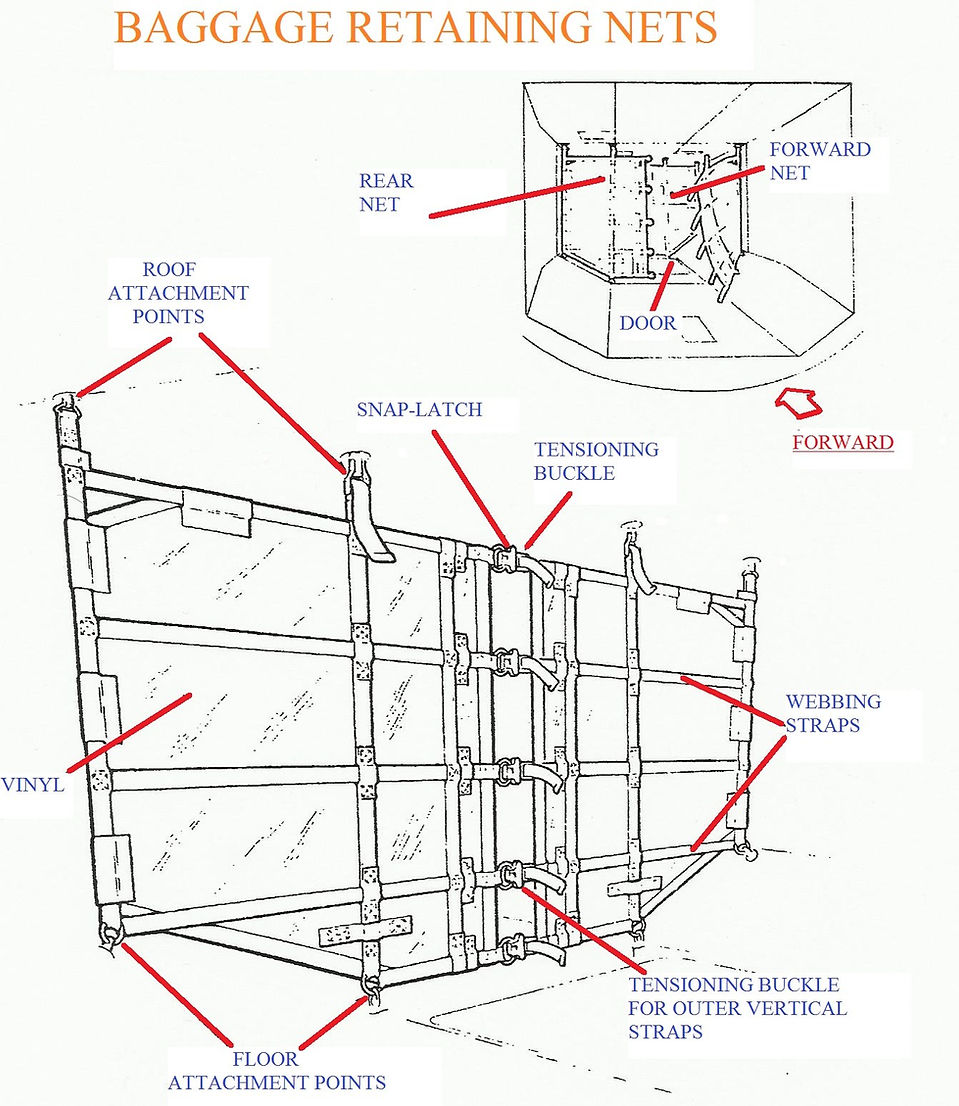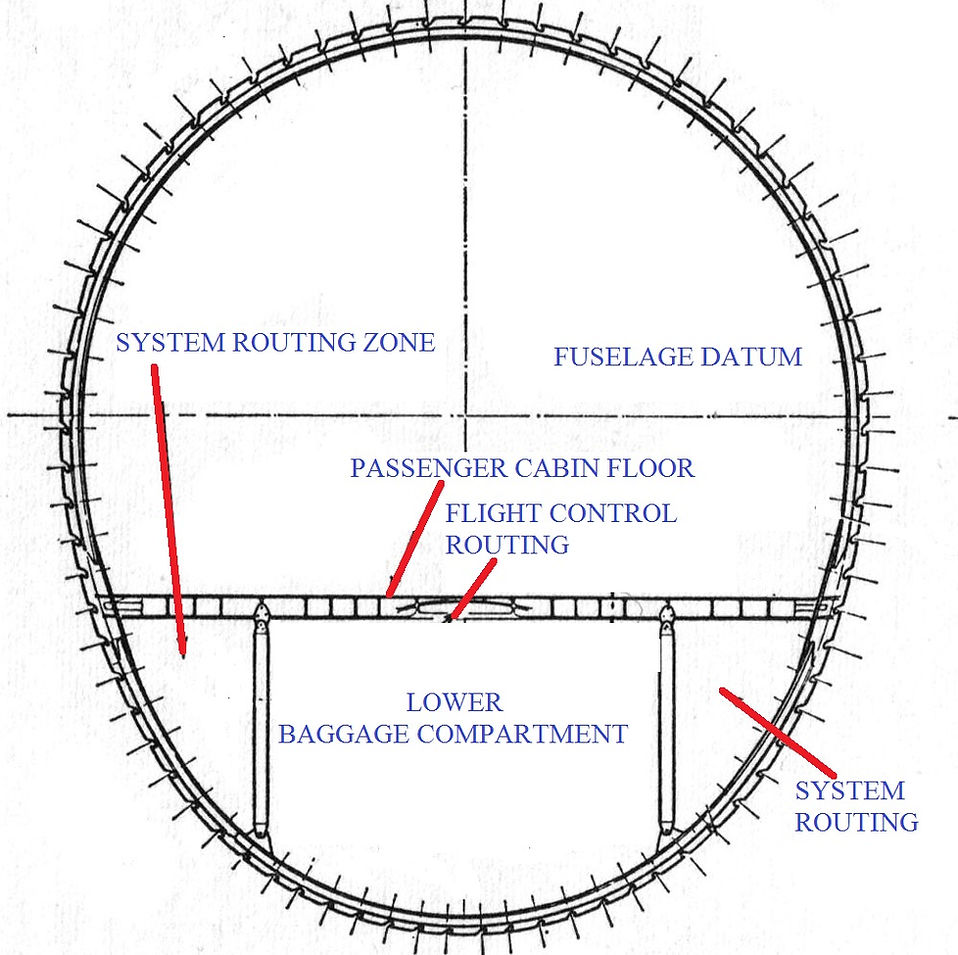Explore the world of Concorde with Heritage Concorde
Concorde Lower Baggage Compartment
The lower baggage compartment, has a capacity of 227 cu ft (6.427 cum.), and is located beneath the passenger compartment floor within the pressurised fuselage of the aircraft in zones 131 and 132. It has a ventral door and is fitted with lighting and a smoke detection device. This is a space type smoke detector unit and is flush fitted in the roof of the compartment aft of the door flood lamp fitted above the door in the ceiling of the compartment. The smoke detector, which is sensitive to the presence of smoke and hydraulic fluid mist, permits air from the baggage compartment to flow through its perforated metal cover. Should smoke or hydraulic fluid mist be present in the compartment an amber SMOKE DETECT caption light at the Flight Engineers station will illuminate. The lower baggage compartment has no direct connection to the air distribution system, but is cooled or heated by air ducted from the flight deck compartment air supply.
The lower baggage compartment has no direct connection to the aircraft air distribution system, but is cooled or heated by air ducted from the flight compartment air supply.
The air which is supplied by flexible ducts at every frame bay a long the length of the compartment, circulates around the outside of the compartment. Pressure equalization between the baggage compartment and the surrounding pressurized area and the passenger compartment is effected by leakage through the panel joints.

Baggage Compartment Doors
The door is the only means of access to the compartment, unless the passenger compartment floor panels and access panels are removed. The door is situated on the underside of the aircraft fuselage aft of the nose wheel bay. It is counterbalanced with spring attached to hinge arms.
There is a door micro-switch which is the primary control for the compartment lights, and this is set in the side of the door aperture. There is another micro-switch which is activated by the door latch bolt which is connected to the ‘doors unlocked’ warning panel, and additionally there is a master warning RED caption light which will illuminate on the overhead panel in the flight deck, all these warning will inform the flight crew if the door as not been closed correctly.
The baggage compartment door can only be opened from outside of the aircraft. To open the door, the circular end of the door handle must first be pressed to spring it out of its recess, then the handle is turned clockwise and the door pushed upward and to the left-hand side of the aircraft.
To shut the door, it must be pulled down into its aperture and the door handle turned counter-clockwise and returned to its recess.
The Baggage Compartment Lighting
There are five filament lamps that provide general illumination for the compartment, and a flood Lamp which illuminates the door area.
The filament Lamps are contained in separate assemblies with flush fitting protective translucent covers, and are spaced a long the left-hand and right-hand sides of the compartment ceiling.
The flood lamp, which is flush fitted in the compartment roof above the baggage door, comprises of a single-contact bayonet lamp in an elliptical reflector housing containing a diffused glass lens behind a protective metal grille.
There is an ON-OFF switch on the Left-hand sidewall near the door which controls all the lights in the baggage compartment.
The baggage compartment lights are supplied with power from ground electrical power only, and are switched on when the door is opened by the door micro-switch which has the primary control over the lights, secondary control is via the
ON-OFF lights control switch.
Floor Panels
The floor panels are similar in construction to the passenger compartment floor panels and are fitted with lashing rings set into recesses in the panels.
Net attachment points are recessed into the inclined outer panels of the floor.
Sidewall Panels
The sidewall panels comprise of an envelope of fibreglass skins which are filled with thermal insulating material. They are attached to sealing strips, support members, blocks and brackets on the fuselage frames with studs and grommets for quick release. There are doors that allow access to the cabin window desiccator units; these are set into the sidewall panels, one on the Left-hand side and one on the right-hand side of the compartment.
Bulkhead Panels
The compartment bulkhead panels, which are made of a fibre glass skinned nomex core honeycomb construction, are fitted to the baggage compartment bulkhead structures. The removal of the front bulkhead upper panels allows access to the water system tanks, air filters, discharge valves and vacuum pumps. Removal, of the rear bulkhead panels allows access to the insulation and vapour seal membrane of the forward bulkhead of number 9 fuel tanks, and the radio altimeter units.
Roof Panels
The roof panels are fabricated from resin impregnated fibreglass. They have apertures for the lighting, lashing and net cleats, a smoke detector and access panels, and are secured to the passenger compartment floor structure with the studs held captive in the panels with grommets. Joints between the panels are covered with joint strips, and the joint between the roof panels and sidewall panels are covered with angle strips.
Baggage Retaining Nets
Two nets, each comprising of a vinyl covered web of vertical and horizontal straps, are provided to retain the stowed freight and keep it clear of the compartment door during flight. Each net is fitted transversely in two halves to the floor and roof attachment points and with the tensioning buckles on the side nearest the door.
When fitted, the net is tensioned by first tightening the inboard vertical straps. The outboard vertical straps are then made taut by tightening the buckle on the lower horizontal strap, and finally the remaining horizontal straps are tightened to strain against the vertical straps
There is another similar net which is fitted forward of the compartment door at frame 29B, this as the tensioning buckles on the side nearest the door.
NOTE:
These nets are superseded by one piece nets of open mesh construction. The nets are tightened by first tightening the four vertical straps and finally tightening the bottom horizontal strap. When not in use the nets are stowed on one side of the hold by clipping the hook onto the ‘D’ ring.
Smoke Detector Unit
A space type smoke detector unit is fitted to the rear bulkhead of the compartment, in the upper right-hand corner. The detector unit is connected to a SMOKE DETECT caption light at the Flight Engineers station in the flight deck compartment.

A stowage pannier is installed on the right-hand side of the hold entrance door. It comprises of a curved panel of honeycomb core which is sandwiched between fibreglass skins which is hinged to the floor, and netting that forms the sides between the panel and the compartment sidewall.
The panel can be secured in any one of three positions: fully extended, half extended or stowed against the sidewall. There is a hinged hatch in the panel that facilitates loading, and when open it can be restrained by a bungee at the front of the panel.
NOTE:
The pannier has been removed from aircraft modification CM.42076.
